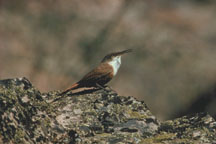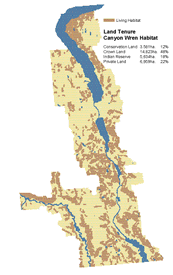|
Habitat Atlas for Wildlife at Risk
Canyon Wren
Catherpes mexicanus

Canyon
Wren
|

- Length: 12 cm.
- Small, with slim, slightly curved bill.
- Rusty plumage, with a dark rufous-brown belly
contrasting with a white breast and throat.
Status:
British Columbia Blue List
Special Significance
In Canada, the Canyon Wren is found only in the Southern
Interior of British Columbia but the heart of the
range is in the Okanagan Valley south of Penticton.
This species is at risk because of its small provincial
population size, vulnerability to human disturbance
and degradation of cliff habitat. The survival of
this rare bird could be assisted by protecting cliff
nesting sites and discouraging human removal of talus.
Further studies are required to determine the distribution
and population status within the Okanagan Valley.
Distribution
- In Canada, locally distributed in the Okanagan Valley between
Osoyoos and Naramata, occasionally seen in fall and winter north
to Vernon;
in the Similkameen there is suitable habitat but
only 2 known localities from Hedley and Chopaka at the south end
of Richter Pass; also occasionally
breeds near Castlegar.
- The main Canadian range of the Canyon Wren is the Okanagan
Valley south of Penticton; it is found in arid
mountains south to southern Mexico.
- Good places to see Canyon Wrens include the rock bluffs
at Vaseux Lake, the east side of Skaha Lake, and
the Little Tunnel on the Kettle Valley Railroad north of Naramata.
- Found up to 435 metres elevation in the Okanagan.
Habitat
- Canyon Wrens live in rugged terrain fractured cliff faces, talus
slopes, rocky bluffs and gorges, canyon walls with
large boulders or rock outcroppings.
- Cliffs and canyons, interspersed with open, patchy
forests of ponderosa pine and Douglas-fir in shrublands
featuring big sagebrush, rabbitbrush and antelope brush.
- Require rock cliffs with deep crevices, small caves
or very large diameter talus for nesting; they
prefer large angular boulders with nooks and crannies for nesting.
- Nests have been located on ledges below overhanging
cliffs, behind large boulders, and on a narrow
ledge on a cliff face.
Reproduction
- Normally lay 5 or 6 eggs from mid-April to early August.
- May raise two broods in a season; eggs laid in late
April or May with possibility of second brood
in late June or early July.
- Nests are bulky cups of twigs with lichens, moss and
fine grass; nests often include large amounts of
spider webs, wool, and human-made artifacts.
Food Habits
- Diet includes insects, spiders and other invertebrates.
- Search for food in rocky habitats, including shady
crannies, caves, deep rock crevices and large
diameter talus on lower slopes.
Interesting Facts
- Canyon Wrens are most easily recognized by their beautiful songs
that carry great distances from their cliff habitat.
The song of clear, descending notes evoked this comment, "Ringing
off immense cliffs or echoing from huge boulders, the cascade of
clear whistled notes
is not easily forgotten."
Threats
- Successive severe winters can significantly impact
local Canyon Wren populations.
- Wrens are disturbed by human activities, such as
rock climbing, removal of talus and mining
on rock canyons and cliffs.
Management Considerations
- Discourage rock climbing and other forms of
disturbance on cliffs used by Canyon Wrens.
- Discourage removal of talus for rip-rap.
- Avoid blasting cliffs when developing urban areas
or highways.
- Protect known nest sites from human disturbance.
|
References
1. Cannings, R.A., R.J. Cannings and S.G. Cannings. 1987. Birds of
the Okanagan Valley, British Columbia. Royal British Columbia Museum,
Victoria, BC.
2. Campbell, R.W., N.K. Dawe, I. McTaggart-Cowan, J.
Cooper, G. Kaiser and M.C. McNall. 1997. Birds of British Columbia:
Volume 3. University of British Columbia Press, Vancouver, BC.
3. Terres, J. 1980. The Audubon Society Encyclopedia
of North American Birds. Alfred A. Knopf, New York.
|